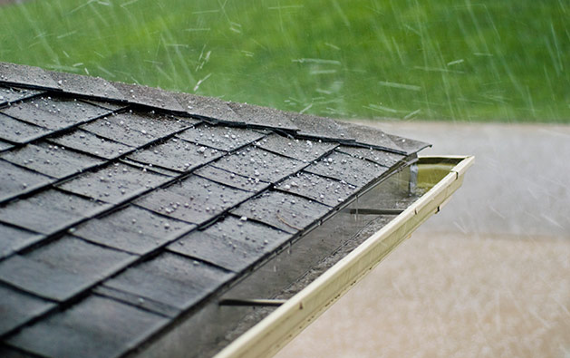- BY Rain Proof Roofing
- POSTED IN Blog
- WITH 0 COMMENTS
- PERMALINK
- STANDARD POST TYPE

According to the NOAA’s historical data, April, May, and June are the months out of the year where the highest number of hailstorms are reported. That means we are in high hail season for the next couple of months and this post can be very helpful to homeowners, especially if you live in Texas. Texas is infamous for hailstorms including the 2016 record breaking storm that caused $3.5 billion dollars in damages, the costliest hail event to affect the United States. (NCEI) In this post we’ll go over some frequently asked questions that we get from homeowners, while giving you an easy guide to spot hail damage without getting on the roof.
What are the first things you should do if you believe your roof was damaged by a hail storm?
Even if you do not think your home was damaged it is smart to safely go outside, grab a hailstone, and take a picture of it. Try to take a picture comparing the stone to a quarter, golf ball, or something that solidifies the size. The size of the hailstone is the first step in evaluating whether or not the shingles on your roof could have been damaged. Also, proving the size of the hailstone with a picture will help get your claim approved if your roof has damage.

It could be difficult and dangerous to climb up on your roof to check for damage. We always recommend homeowners to contact us before trying to inspect their own roof. Although, there are a couple ways to figure out if your roof was damaged without getting on the roof. Many times a hailstone big enough to damage your roof will dent your gutters and downspouts. You’ll usually be able to see this from the ground level. Some other things to check are your mailbox, windowsills and casings, and A/C units. Also look for chipped paint on your siding and any other painted areas. Here’s what some of these things would look like:
Damage Around the Property
Gutters dented from hailstones and/or hailstone marks splattered on A/C.
Inspecting from the Roof
In the case that you are able to see your roof or climb on top remember to practice safety first. Use the 4 to 1 rule when using a ladder (for every four feet of height you have to climb, move the bade one foot away from the wall) and make sure it is in perfect working condition, also wear soft soled shoes for better grip. The first thing you’ll notice if you have damage on the roof are the vents, pipes, skylights, and chimney caps. These roof features will have significant dents and maybe even cracks or holes.
Damage to Shingles
Onto to the most important part of the roof, the shingles. When hail damages the shingles it knocks off protective granules which compromises the integrity of the roof system. Eventually these hail impacts on shingles sustained during a hailstorm lead to roof leaks. Sometimes it’s easy to spot the damage, but more often than not it takes a trained eye to spot all the damage your roof might have received. Take a look at the pictures below, if any of these look like your shingles after a hailstorm it might be time to call your insurance company.
What size hail can damage a roof?
Hail damage depends on the size, velocity, and density of the hailstones. Not all hail storms will damage your roof. Usually hail stones have to be at least 1” or larger to damage a roof depending on the material and age. See our size chart below for what size hail can damage your roof. If you don’t know what type of roof you have, get a professional roofer to check it out.
| Material | Size of Hailstone |
| 3-Tab asphalt shingles | 1” |
| Fiber-cement Tiles | 1 ¼ ” |
| 30-year laminated shingles | 1 ½ ” |
Will insurance pay for a new roof?
This depends on your insurance policy and the type of damage your roof received. Hail damage can be either functional or cosmetic. Functional damage refers to damage that jeopardizes the integrity of the roof and causes leaks in the future. Cosmetic damage refers to damage that does not affect the roofs ability to perform its function. Technically, most insurance companies want to see eight hits within a 10’ x 10’ surface area on at least three sides of the roof in order to pass the claim. It’s best to contact a trusted roofer so they can be present when the adjuster comes to inspect the roof and help point out some damages the adjuster might miss.











